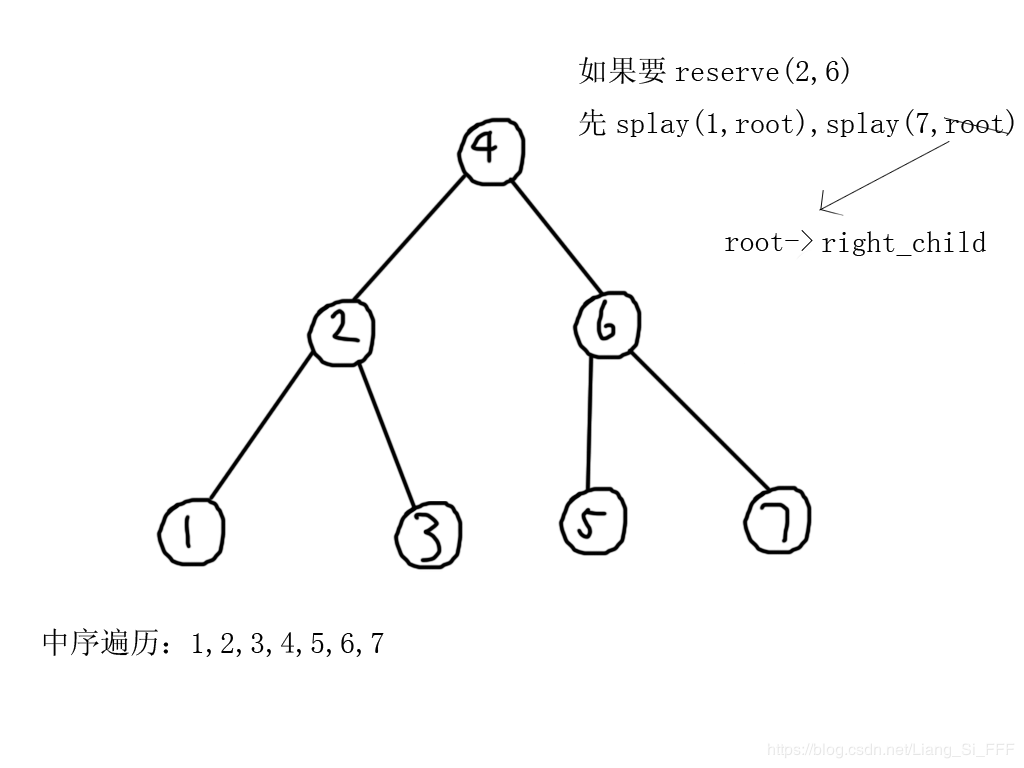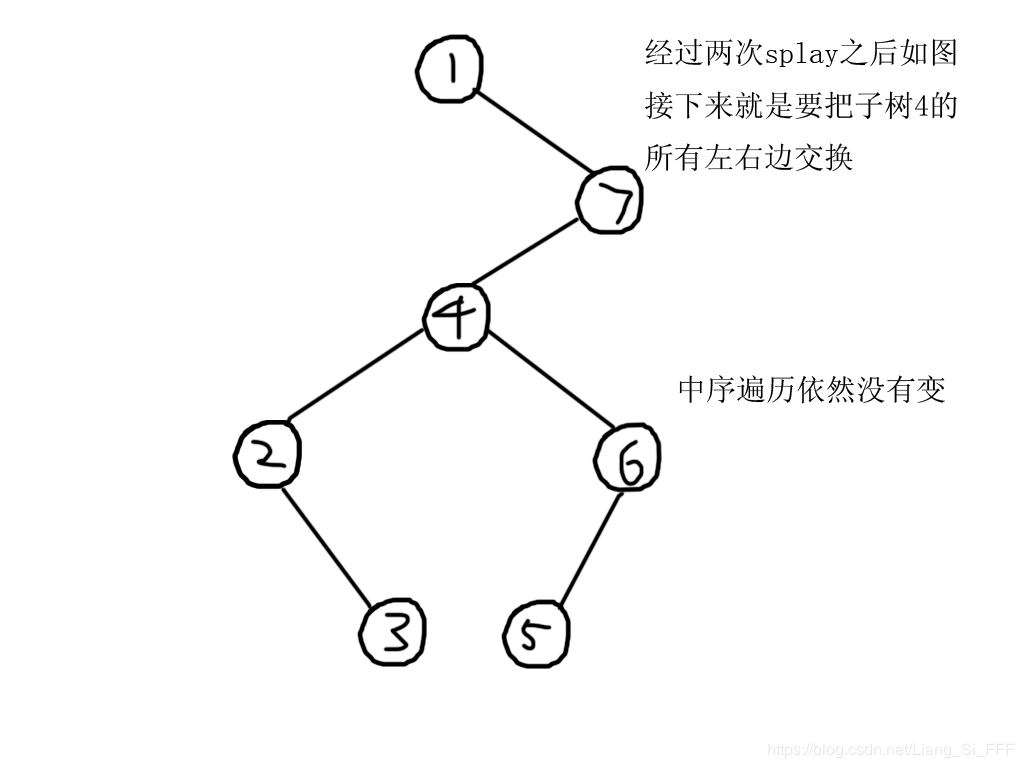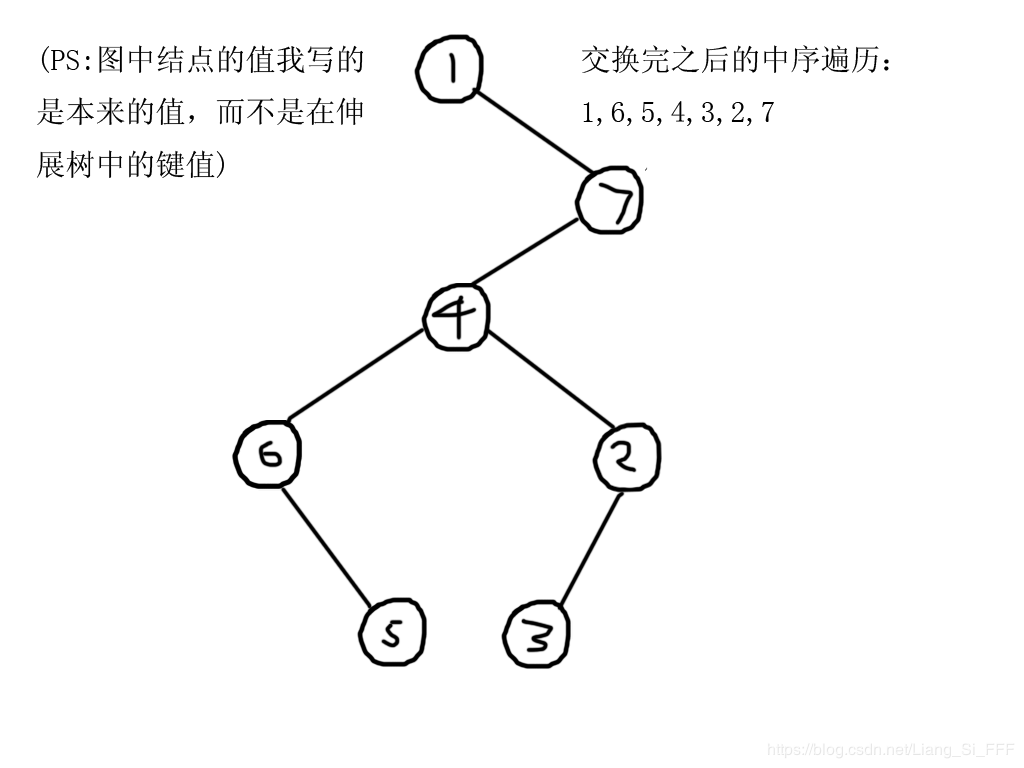【阶梯报告】洛谷P3391【模板】文艺平衡树 splay
2018-11-20 03:15:14来源:博客园 阅读 ()

【阶梯报告】洛谷P3391【模板】文艺平衡树 splay
题目链接在这里[链接](https://www.luogu.org/problemnew/show/P3391)
最近在学习splay,终于做对了这道模版题,虽然不是很难的样子。~~但是我一开始并不会做,而且看完题解之后还打错一直打不对,调试了很久~~
下面是题目简述
现在给你一个长度为n的序列,序列元素初始为1,2,3...n,同时有m个操作,每个操作给定一个L和R,表示将[L,R]区间的数进行翻转。
输出:完成所有操作之后的序列(n,m≤100000)
首先,这道题用暴力是肯定超时的。但是既然连题目都提示用splay做这道题了,那么我们自然可以用splay做这道题。
首先我们想一下splay的树的性质。
### 性质
1. 如果我们给每一个点添加一个键值,这个键值表示的是这个点在序列中的位置,那么我们对splay树进行中序遍历之后,得到的序列就是原来对应的序列。
2. 对于splay树,无论是进行zip还是zap操作,都不会影响最终中序遍历的结果。因为zip和zap都是在保证二叉查找树的性质的前提下进行的。
3. 假如我们splay(L-1,root),然后,splay(R+1,root->right_child),那么我们就会惊奇地发现,区间[L,R]内的所有点都在R+1这个结点的左子树种。
4. 假如我们把任意一个结点的子树中的每一个结点的左右子树都换边,(包括自己)那么最终中序遍历的结果就是——除了被翻转的子树以外,其他所有点的中序遍历都没有变化,而子树中的所有节点(包括子树根节点)的中序遍历刚刚好反了过来。(你们可以自己画一个图试一下,或者说,如下图)


思路
第一种简陋的想法
1. 以1,2,3,4...n为键值插入splay树(或者直接构建一棵平衡树就行,因为你已经知道会有哪些元素插入树中)。之后,我们对树的所有操作都不需要用到键值,直接根据zip和zap不会改变中序遍历的特性进行改变。
2. 翻转区间的时候,先splay(l-1,root),splay(r+1,root->right_child),然后再把r+1这个结点的左子树的所有左右孩子交换即可。
虽然这么做确实可以做对题目,但是这样会有几个需要注意的地方。
1 . 假如要reserve(1,n),那么我们将会splay(0,root)和splay(n+1,root->left_child),但是树中没有0和n+1这两个结点。因此一开始的时候我们就应该加入INF和-INF,充当卫兵的作用。
2 . 交换子树中所有结点的速度实在是太慢了,和o(n)压根没有区别。这样根本就没有变快。
优化的方法
1. 翻转树的时候不需要把整个子树都交换,只要采取线段树的懒标记的方法做一个标记即可。
- 标记完之后,假如等一下再标记同样的区间,只要异或一下1就可以了
- 假如要splay的点在已经翻转过的子树里面,那么我们到时候只要在寻找结点的过程中进行push_down就可以了。
- 在输出整棵splay树的时候,也注意一下push_down就可以了。
具体方法
1. 把所有的元素都塞进splay里面。由于一开始就是有序的,所以你既可以一个一个地insert进去,也可以直接就构建一个十分平衡的splay树
2. 对于每一个翻转操作,首先splay(l-1,root),splay(r+1,root->right_child),然后再把r+1的左子树打上标记即可
3. 要点:每次在find一个结点的时候,一定要先push_down,然后再进行操作。
4. 最后输出整棵树的时候也注意一下push_down
下面是我的代码,可能不是很看得明白。
1 #include<cstdio> 2 using namespace std; 3 const int N=100010; 4 const int INF=100000000; 5 struct node 6 { 7 int lc,rc,fa,size,val,mark;//mark就是懒标记,val是本来的值,size是子树(包括自己)的大小 8 node() 9 { 10 lc=rc=fa=size=val=mark=0; 11 } 12 }tree[N]; 13 int root=1,tot=1,FIRST=1; 14 void build(int,int,int,int);//直接用递归在刚开始的时候建立一棵比较平衡的树 15 void push_down(int); 16 void zip(int);//左旋 17 void zap(int);//右旋 18 void initailize();//放入INT和-INF作为卫兵 19 void splay(int,int); 20 int find(int);//用于寻找splay树中的第几大的数。毕竟在序列中排第k的数就是在splay中第k大的数 21 void reverse(int,int); 22 void print(int);//用递归输出整棵树 23 int main() 24 { 25 int n,m; 26 scanf("%d%d",&n,&m); 27 build(1,1,n,0); 28 initailize(); 29 while(m--) 30 { 31 int l,r; 32 scanf("%d%d",&l,&r); 33 reverse(l+1,r+1);//由于有-INF的存在,所以翻转[l,r]区间的时候,其实是翻转[l+1,r+1]区间 34 } 35 print(root); 36 return 0; 37 } 38 void build(int x,int l,int r,int father) 39 { 40 tree[x].fa=father; 41 tree[x].size=1; 42 if(l==r) 43 { 44 tree[x].val=l; 45 return; 46 } 47 int mid=(l+r)/2; 48 tree[x].val=mid; 49 if(mid==l) 50 { 51 tree[x].rc=++tot; 52 build(tot,r,r,x); 53 tree[x].size+=tree[tree[x].rc].size; 54 } 55 else 56 { 57 tree[x].lc=++tot; 58 build(tot,l,mid-1,x); 59 tree[x].rc=++tot; 60 build(tot,mid+1,r,x); 61 tree[x].size+=tree[tree[x].lc].size+tree[tree[x].rc].size; 62 } 63 } 64 void initailize() 65 { 66 int p=root; 67 while(tree[p].lc!=0) tree[p].size++,p=tree[p].lc; 68 tree[p].size++; 69 tree[p].lc=++tot; 70 tree[tot].fa=p; 71 tree[tot].size=1; 72 tree[tot].val=-INF; 73 p=root; 74 while(tree[p].rc!=0) tree[p].size++,p=tree[p].rc; 75 tree[p].size++; 76 tree[p].rc=++tot; 77 tree[tot].fa=p; 78 tree[tot].size=1; 79 tree[tot].val=INF; 80 } 81 void inline push_down(int x) 82 { 83 if(tree[x].mark) 84 { 85 int L=tree[x].lc,R=tree[x].rc; 86 tree[L].mark^=1; 87 tree[R].mark^=1; 88 tree[x].mark=0; 89 tree[x].lc=R; 90 tree[x].rc=L; 91 } 92 } 93 void zip(int x) 94 { 95 int y=tree[x].fa; 96 tree[y].rc=tree[x].lc; 97 tree[x].lc=y; 98 tree[x].fa=tree[y].fa; 99 tree[y].fa=x; 100 if(tree[x].fa) 101 if(tree[tree[x].fa].lc==y) 102 tree[tree[x].fa].lc=x; 103 else tree[tree[x].fa].rc=x; 104 else root=x; 105 if(tree[y].rc) 106 tree[tree[y].rc].fa=y; 107 tree[y].size=tree[tree[y].lc].size+tree[tree[y].rc].size+1; 108 tree[x].size=tree[tree[x].lc].size+tree[tree[x].rc].size+1; 109 } 110 void zap(int x) 111 { 112 int y=tree[x].fa; 113 tree[y].lc=tree[x].rc; 114 tree[x].rc=y; 115 tree[x].fa=tree[y].fa; 116 tree[y].fa=x; 117 if(tree[x].fa) 118 if(tree[tree[x].fa].lc==y) 119 tree[tree[x].fa].lc=x; 120 else tree[tree[x].fa].rc=x; 121 else root=x; 122 if(tree[y].lc) 123 tree[tree[y].lc].fa=y; 124 tree[y].size=tree[tree[y].lc].size+tree[tree[y].rc].size+1; 125 tree[x].size=tree[tree[x].lc].size+tree[tree[x].rc].size+1; 126 } 127 void splay(int x,int aim) 128 { 129 aim=tree[aim].fa; 130 while(tree[x].fa!=aim) 131 { 132 int y=tree[x].fa; 133 int z=tree[y].fa; 134 if(z==aim) 135 if(tree[y].lc==x) 136 zap(x); 137 else zip(x); 138 else if(tree[z].lc==y&&tree[y].lc==x) 139 zap(x),zap(x); 140 else if(tree[z].rc==y&&tree[y].rc==x) 141 zip(x),zip(x); 142 else if(tree[z].lc==y) 143 zip(x),zap(x); 144 else zap(x),zip(x); 145 } 146 } 147 int find(int k) 148 { 149 int p=root; 150 while(1) 151 { 152 push_down(p); 153 if(tree[tree[p].lc].size>=k) 154 p=tree[p].lc; 155 else 156 { 157 k-=tree[tree[p].lc].size; 158 if(k==1) return p; 159 k-=1; 160 p=tree[p].rc; 161 } 162 } 163 } 164 void reverse(int l,int r) 165 { 166 int L=find(l-1); 167 splay(L,root); 168 int R=find(r+1); 169 splay(R,tree[L].rc); 170 tree[tree[R].lc].mark^=1; 171 } 172 void print(int x) 173 { 174 if(x==0) return; 175 push_down(x); 176 print(tree[x].lc); 177 if(tree[x].val!=INF&&tree[x].val!=-INF) 178 { 179 if(FIRST) 180 { 181 FIRST=0; 182 printf("%d",tree[x].val); 183 } 184 else printf(" %d",tree[x].val); 185 } 186 print(tree[x].rc); 187 }
对了,顺便说一下,为什么我看的资料书里面,不同的平衡树的zip是不一样的?有些是表示左旋,有些是表示右旋,zap也是一样,导致我现在都是按照自己的标准来了。
我在CSDN也发了。https://blog.csdn.net/Liang_Si_FFF/article/details/84190616
标签:
版权申明:本站文章部分自网络,如有侵权,请联系:west999com@outlook.com
特别注意:本站所有转载文章言论不代表本站观点,本站所提供的摄影照片,插画,设计作品,如需使用,请与原作者联系,版权归原作者所有
- 洛谷P1164->小A点菜 2020-05-18
- 洛谷P1907口算练习题 2020-03-24
- 2019.3.14解题报告&补题报告 2020-03-22
- 结题报告--hih0CoderP1041 2020-03-17
- 结题报告--P5551洛谷--Chino的树学 2020-03-13
IDC资讯: 主机资讯 注册资讯 托管资讯 vps资讯 网站建设
网站运营: 建站经验 策划盈利 搜索优化 网站推广 免费资源
网络编程: Asp.Net编程 Asp编程 Php编程 Xml编程 Access Mssql Mysql 其它
服务器技术: Web服务器 Ftp服务器 Mail服务器 Dns服务器 安全防护
软件技巧: 其它软件 Word Excel Powerpoint Ghost Vista QQ空间 QQ FlashGet 迅雷
网页制作: FrontPages Dreamweaver Javascript css photoshop fireworks Flash
